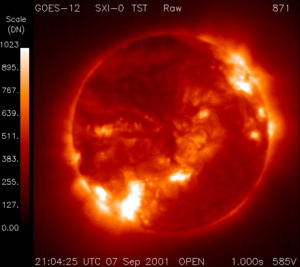Astronomy:Solar X-ray Imager
Solar X-ray Imager (SXI) are full-disc X-ray instruments observing the Sun aboard GOES satellites. The SXI on GOES 12 was the first of its kind and allows the U.S. NOAA to better monitor and predict space weather.
Operation
The Solar X-ray Imager aboard the GOES 12, GOES 13, GOES 14, and GOES 15 NOAA weather satellites is used for early detection of solar flares, coronal mass ejections (CMEs), and space phenomena that impact human spaceflight and military and commercial satellite communications.[1] The Solar X-ray Imager was the first X-ray telescope to take a "full-disk" image of the Sun, providing forecasters with the ability to detect solar storms and real-time solar forecasting by the Space Weather Prediction Center (SWPC).[2]
Imagery
The SXI aboard GOES 12 is a Wolter Type I (Wolter telescope) grazing incidence X-ray telescope designed to record coronal images in continuous sequence at 1-minute intervals. The Solar X-ray Imager obtains images at multiple wavelengths on the electromagnetic spectrum from 6 to 60 angstrom units (Å).[3] The imagery obtained by the XSI and XRS on GOES 12 allowed forecasters to see space phenomena such as coronal holes, whose geomagnetic and proton storms impact electrical grid systems on Earth as well as radio communications and satellite communications systems.[2][3]
Failure and termination of the GOES 12 instrument
The XSI and XRS sensors on GOES 12 failed due to a problem with the electrical system which controls the north-south motion functionality of the instruments on April 12, 2007. The SXI and XRS currently have the ability to capture and record images. Due to limited field of view of the x-ray instrumentation, the XSI and XRS and been permanently deactivated.[4]
See also
- 2001 in spaceflight
- List of GOES satellites
- Geomagnetism
References
- ↑ "GOES Solar X-ray Imager". NOAA/SWPC. http://www.swpc.noaa.gov/products/goes-solar-x-ray-imager-sxi. Retrieved 2015-06-29.
- ↑ 2.0 2.1 "Environmental Satellite Readied to Detect Solar Storms". NASA/NOAA. 2003-01-30. http://www.nasa.gov/centers/goddard/news/topstory/2003/0130sxi_prt.htm. Retrieved 2009-12-12.
- ↑ 3.0 3.1 "The GOES Solar X-ray Imager". NASA/Marshall Solar Physics. 2007-01-18. http://solarscience.msfc.nasa.gov/SXI.shtml. Retrieved 2009-12-12.
- ↑ "GOES SXI Operational Status (2007-08-24)". Space Weather Prediction Center(SWPC). 2007-08-24. http://www.swpc.noaa.gov/sxi/goes12/goes12_op_status.html. Retrieved 2009-12-12.
 |




